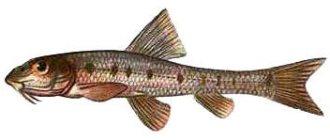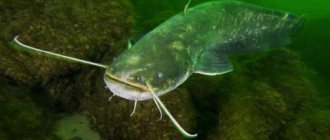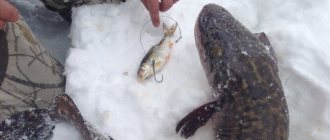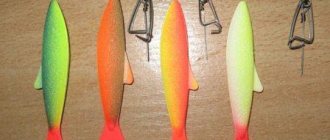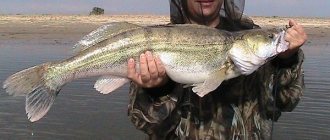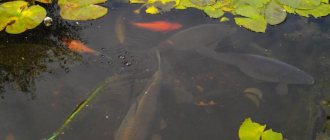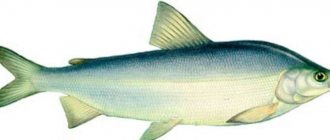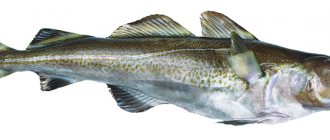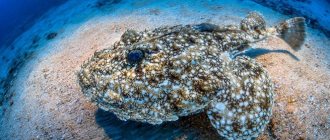Cyprinids are an unusually rich family. Some of its representatives are ubiquitous, but there are fish whose populations are small. These fish include the sopa (white-eye) and its relative the bluefish. These two fish form a family branch.
The bluefish is similar to other members of the family; there are similarities with bream and silver bream. There are a number of distinctive features by which these fish can be unmistakably distinguished. First of all, this is the coloring and the bluebird got its name thanks to it. His back is dark blue with an added green tint. The abdomen, like most river fish, is light. This coloring is a protective mechanism. Reservoirs are characterized by diffuse lighting; the shadow falling on the light areas of the bluefish’s body makes it monotonous for predators who happily hunt the fish. This allows it to merge with the water column.
The bluebird has an elongated body with flattened sides. The scales are small. The head is pointed. The fins of the fish are yellowish. It lives in bodies of water with warm water, but can also be found in calm rivers.
The population of this fish is low, this is due to special environmental requirements. This factor makes bluefish fishing an interesting activity for both professional fishermen and amateurs.
The population was not always small. At the beginning of the last century, blue salmon was an important commercial fish in Russia. About 15 million fish were caught per year.
Blue Size
The bluefish is a small fish that is not a trophy fish. Its weight varies depending on its habitat, but it does not exceed 1.2 kilograms. The average size of blue bream is from 20 to 40 centimeters, with a weight of 200-600 grams, respectively. Weight and length depend on the reservoir or river in which the bluegill lives. The larger the food supply, the larger the individual will be.
The largest bluegill ever caught was 2 kilograms. Mention of this fish is found in the “Encyclopedic Dictionary of Brockhaus and Efron.” In reservoirs and reservoirs, fish growth is more active than in the river, so lake fish are larger than their river counterparts. On average, fish live 10-12 years. However, there is evidence of the capture of a 19-year-old bluegill in a lake in Karelia.
Appearance of blue fish
In appearance, bluefish differ from young bream only in their elongated anal fin and peculiar coloring. Under normal conditions, this fish has a bluish-green back and a light belly. Its color changes interestingly when removed from water. When exposed to air, the entire body of a male bluebird becomes covered with spots that are characteristic only of him, reminiscent of kerosene stains. Apparently this is where one of its many names came from. In each region this fish is called differently. If you hear names such as sopa, singa, goluha, durbala or goggle-eye, be sure that we are talking about the same fish.
River bluebills are smaller in size than those that live in calmer reservoirs, since in calmer water the bluebill has a greater opportunity to find a sufficient amount of food for itself. It is not suitable for picking it up from the bottom. Pale gray unpaired fins and yellowish pectoral fins have a dark border.
The most common weight of bluegill is 400 g, but some of the most successful anglers have managed to catch specimens exceeding 1 kg.
Blue bream spawning
Sexual maturity occurs at 4 years of age.
Males mature earlier than females. At this time, the fish reaches sizes of up to 18 centimeters. The spawning of blue bream in different reservoirs occurs at different times. This is related to the temperature of the water. It must be at least 10 degrees Celsius. In southern reservoirs, spawning begins in mid-April. Fish living in the north begin to spawn much later. During the spawning season, fish form large schools. Males put on a “nuptial outfit” and announce their readiness to spawn. Dark dots form on the scales. The spawning process lasts 1-2 weeks. The amount of eggs spawned directly depends on the size of the female; the larger the fish, the higher the fertility. Females weighing 300 grams lay about 30 thousand eggs, and females weighing 600 grams are twice as many. In addition, the age of the fish also affects fertility. The older the fish, the more eggs it spawns.
Fish caviar is 1-1.5 millimeters in size and has a beautiful pink-orange color. Bluefish spawn only in shallow water. The eggs are spawned on vegetation stems, algae, and leaves. Depending on weather conditions, the time of appearance of fry varies from 1 to 2 weeks. The warmer the water, the faster the fry will hatch. The larvae that emerge from the eggs spend the first week of their life on plant stems and feed on the yolk sac. Upon reaching two weeks of age, the fry begin to look for food. The fry grows very actively and by the end of summer reaches a length of 6-8 centimeters. It feeds on molluscs and crustaceans.
Feeding and reproduction of mature blue bream
All small cyprinids are characterized by peaceful coexistence with other fish species. That is why their diet consists of plankton, benthos, ciliated and polychaete worms, small crustaceans and mollusks, and various insect larvae that live both in bottom sediments and in the intermediate layers.
In unfavorable years, the basis of the diet of the blue bream is algae, submerged plants, caviar and hatched fry of other fish. In turn, the blue tit population suffers greatly from constant persecution by perch, pike perch, pike, and burbot.
Spawning of blue salmon begins at a water temperature of +8-9°C and gradually increases its intensity as it warms up to +17-18°C. Depending on the geographic location of the region, this could be any month from April to June. The spawning ground is shallow water (0.5-1.0 m) with an abundance of vegetation, last year’s leaves, snags, and stones. Such a substrate serves as a reliable and well-camouflaging basis for 25-100 thousand sticky light orange eggs with a diameter of 0.8-1.5 mm, which are laid by the female in one go.
The time of puberty of the blue bream depends on climatic conditions, the quality of the food supply, the total population size and usually occurs in the 3-5th year of life with a length of 18-25 cm. The size of the individual directly affects the amount of eggs laid. In this regard, adult fish aged 7-8 years are several times more productive than sexually mature young fish.
To learn more:
What is bleak and where does it live?
The incubation period for the development of eggs is 1-2 weeks. The hatched larvae, 5-6 mm long, motionlessly attach to the vegetation at the upper edge of the water and continue their growth due to the energy reserves of the yolk sac and the filtration of plankton. After 7-10 days they turn into fry, which begin to feed on nutritious benthos and by the end of summer grow to 6-7 cm.
Habitats of blue bream
Bluefish is a lake and river fish. You will not find it in fast-flowing cold mountain rivers and stagnant lakes. To live, fish need warm water, quiet reaches and flowing calm water.
The distribution area of the fish is not as large as that of many cyprinids. The main habitat of the blue bream is in the European part of Russia. Found from the Neva and Volga to the Urals. A large population lives in the Ivankovsky and Rybinsky reservoirs. Found in southern rivers of Sweden and Finland.
A small population lives in Lake Onega, Svir, and the lower reaches of the Kama. It can be selectively found in the lakes of Karelia and in the south of Ladoga.
The anadromous form of the blue bream lives in the Volga and Narva. Sintz can be found in the Gulf of Riga and the Baltic Gulf of Finland, in the northern parts of Azov and the Caspian Sea. In 1957, the bluegill was artificially released into the Simferopol reservoir.
A little biology
The bluebird is a representative of the genus of the same name from the Karpov family. Its closest relative is the white-eye (sopa). The fish apparently received its name because of the bluish tint of the dorsal part, especially noticeable when the sun's rays hit its body at an angle.
The bluefish has a tall and flat body; many anglers classify it as a so-called bream fish. According to the description, our today's hero is very similar to both bream and silver bream, but especially to the white-eye, which also belongs to the Sintsov genus.
The bluefish is distinguished by a narrow, pointed snout with a raised mouth, a high dorsal fin and a long, wide lower fin. In body shape it is similar to other breams, but its body height is less with the same length than its closest relatives.
The blue-eye differs from the white-eye by having smaller scales and a greenish-blue back.
External characteristics also include the color of the fins. The gills and pectorals may have a yellowish or reddish color, the rest are simple gray.
The size of the bluegill is not particularly impressive. In regular catches, this fish is rarely longer than half a meter and rarely weighs more than six hundred grams; most often, specimens up to four hundred grams are caught. The body length in this case is 20-30 centimeters. However, there are witnesses showing that in large rivers, in the Volga and the Urals, there were specimens up to a meter long with a mass of over one kilogram two hundred grams.
Attention! According to ichthyologists, in reservoirs the bluebirds in total reach larger sizes than in rivers.
Sintsa lifestyle
The bluenose has a peaceful character and a calm way of life. Blue, a bright representative of his family. It exists peacefully with other fish species. However, its population is threatened by predators: pike, burbot, pike perch. The bluebird forms part of their diet.
The bluefish does not prey on fry and small fish. Its diet: nutritious crustaceans, plankton, worms, mollusks, insect larvae. If there is not enough food of animal origin, the bluegill begins to eat plant foods.
Sins living in lakes are usually larger than their river counterparts. Leads a gregarious lifestyle. You won't find a lone bluebird in the lake. Prefers a depth of 1.5 -2 meters. Despite the fact that this fish is a river-lake fish, it is very demanding on the quality of water and the presence of oxygen in it. Bluefish will not live in swampy water with a silted bottom.
In the summer heat, the bluegill will rest at the bottom of the reservoir where it lives. There, huddled in small groups, the fish feed. It rises to the upper layers only in the morning and evening.
The cold season causes fish to gather in large schools. The fish is preparing for winter. Sinets survive bad weather and frosts in riverbed pits.
Spawning period
3
Sinks reach sexual maturity in the fourth year of life. By this time, it reaches a size of up to 18 cm. For successful spawning, bluegills need the water to warm up above 9 degrees. It occurs in different areas at different times.
In the southern regions, spawning occurs from mid-April. The further north the blue bream’s habitat is, the later it begins to lay eggs. So in mid-latitudes, spawning can begin only by June. During spawning, bluefish form huge schools.
Males at this time acquire a very interesting appearance, demonstrating to females their readiness for the spawning process. Dark dots appear on their fins, and the scales located at the anus are covered with characteristic wide, flattened horny warts.
Bluefish usually spawn at the same time. This process can take from one to two weeks. During this time, the female, depending on age and weight, lays from 4 to 95 thousand eggs.
Blue caviar has a beautiful pink or orange color. The size of each egg ranges from 1 to 1.5 mm.
Females choose stems of aquatic vegetation for future egg laying sites, so during this period, schools of fish move to shallow water.
The time of appearance of fry from eggs depends on the conditions of the reservoir and can range from 7 to 15 days. They spend the first week on algae leaves, to which they firmly stick. At this time, their nutrition consists of the contents of the yolk bladder. Upon reaching a week of age, they are already able to find their own food. In autumn, the fry already grow up to 8 cm.
Females choose stems of aquatic vegetation for future egg laying sites, so during this period, schools of fish move to shallow water.
Eggs are laid only by mature individuals aged 3-4 years and weighing more than a kilogram, which gather in large groups with a quantitative predominance of males. Coastal areas without current with a depth of 25-250 cm and an abundance of vegetation, snags and other grounds for attaching eggs are selected as spawning grounds.
Mass spawning of bream begins when the water warms up above 200C. Depending on the region, this could be April or early May. During this period, males acquire a special color with numerous white tubercles. It’s an impressive sight when bream spawn, which spent the winter in the sea and salty bays.
Ways to catch bluegill
Bluefish actively bite throughout the year, with the exception of the spawning period. The most active fish bite is after spawning: from the end of June until the onset of cold weather. Bluefish fatten up after spawning and will grab both animal and plant baits at any time of the day. They catch it in the morning, in the evening, and throughout the day.
The best tackle for catching bluegill: feeder, float rod and donka. The tackle should be lightweight. It is equipped with hooks No. 3 and 4 according to the domestic classification. It is necessary to take into account the area in which the fish are caught. The optimal fishing line would be a monofilament of 0.25 - 0.3 millimeters, which will withstand snags on vegetation.
The baits and baits used are the same as when fishing for white-eye, silver bream or bream. Favorite food for the blue bream: crushed worms, larvae, maggots, bloodworms. The best bait: shellfish, worms, insect larvae. Sometimes it takes bloodworms and maggots very well.
The bluefish is a cautious fish, like many members of the family. The bite is similar to the white-eye bite, however, it is bolder.
The catch of bluegill differs when fishing with wire. If the current is slow, then you should hook the fish as soon as the float is immersed in the water. At this moment, the bluebird tries to grab the nozzle. The float will roll towards the rod and then begin to move to the side. Once hooked, the fish will want to leave. The main thing when catching bluegill in such a situation is to quickly hook it, otherwise there is a high chance that the fish will leave. In a fast current, the bite is different; at first the float gives a large roll and only then sinks into the water.
If a bottom fishing rod with a roller is used as a fishing rod, then the bite of the bluegill will be decisive and bold. When he sees a worm, he will try to grab it and leave. This haste and some carelessness often lead to self-cutting.
If the fish is hooked, the angler will catch it without effort. The fish will not fight, pull the line or resist. The resistance of the lead is minimal.
The most productive fishing for bluegill is in the summer, in warm but not hot weather. A variety of baits and baits are used. This is the period when the fish is hungry and it will grab such baits as: bread crumbs, wheat, pearl barley, peas and corn, dough.
During the summer heat, biting activity decreases. This is due to the fact that the fish cannot stand the heat and hides at the bottom. Feeds mainly at dusk. The former appetite will return with the autumn coolness.
Winter fishing for bluegill will also be productive. A float or nodding fishing rod with a jig is used. The bait used is the blue bream's favorite delicacy: bloodworms, maggots, and worms. Beads and colored threads attract attention. The maximum bite in winter occurs in the afternoon, from 14:00 to 17:00.
What to catch bluegill with
Seasonality of fishing: spring
Zhoring of the blue bream begins in the spring, when the water just begins to warm up. The taste preferences of fish depend on seasonality, which must be taken into account when planning your fishing trip. The feeding peak of the blue bream is uneven and appears after spawning, in July, at the end of autumn and in February, when the last ice melts. Fish bite almost all year round, so the chances of catching are quite high even in winter. A “garland” is suitable as a tackle for catching bluegill through a hole. Fish can be in the water at any depth level, and a practical device will help you find a promising horizon. For complementary feeding, you can take a ready-made store-bought mixture, small bloodworms or chopped worms. A good catch will be ensured by fishing with a nod rod in several holes. It is advisable to drill them downstream, placing them at a certain distance from each other. Don’t forget that the bluegill bites softly but strongly, so you need to hook it quickly but smoothly.
Seasonality of fishing: summer
During the warm season, the bluegill likes to live in snags, which provide both food and shelter. It is very difficult to catch it in such a place with ordinary gear, so the only way to catch it is to fish from a boat using an onboard fishing rod. It resembles a short spinning rod with a nod at the end and a spinning reel. A load is attached to the fishing line, the weight of which is selected according to the nature of the current: the stronger it is, the heavier the load should be. Two leashes with hooks are attached above the sinker.
In summer, it is better to go fishing with a float rod, since in the warm season bluefish swim in the middle layers of the reservoir. The main condition is that the rod must be sufficiently elastic and not shorter than 5 m. It is better to take a fishing line that is not very thick (up to 0.25 mm). The bluefish is very cautious, so it will probably avoid thick fishing line. For catching fish from the bottom, a feeder with a very sensitive rod or its lightweight version – a picker – will be optimal. Many fishermen opt for a bottom fishing rod with a rubber shock absorber, which allows them to fish at any depth. Among the disadvantages of this gear is its low sensitivity, which can be a problem for an inexperienced fisherman.
Bait and lure
It is important not only to know what kind of fish the bluefish is, but also its taste preferences. It is better to use as bait:
- bread crumb;
- dough;
- larvae;
- maggots;
- peas or corn (preferably canned);
- steamed pearl barley;
- bloodworm;
- earthworms.
Among the lures that are attractive to bluefin, experienced fishermen note oblong-shaped jigs (“droplets” and “ovinki”) of white color. At great depths, luminous baits are suitable. In summer, bluegill are caught on large rivers with small currents. After spawning, it is wise to look for fish in algae and other dense thickets, and in winter - in deep reservoirs with weak currents.
Gastronomic value of sinets
The massive commercial catch in Russia at the beginning of the 20th century is associated with the valuable gastronomic properties of blue salmon meat. Despite the abundance of bones, like most river fish, the meat is highly valued by gourmets for its taste. It is tender and moderately fatty. Sintsa is prepared in all possible ways: boiled, fried, stewed, baked. The low calorie content of fish meat with a high protein content makes bluefish an excellent option for dietary nutrition. The meat has a pleasant taste. It is rich in vitamins, microelements and beneficial substances. All these qualities make this small fish valuable in commercial terms.
Bluefish is a small representative of the carp family, which has tasty, tender, healthy meat. Bluefish fishing is an exciting activity for both amateurs and professional fishermen. To properly catch this representative of the ichthyofauna, it is necessary to apply certain efforts and skills. You should study the habits of the blue bream, seasonal preferences and activity at different times of the year. Knowledge of the characteristics of this fish and a serious approach to fishing will help to properly organize the fishing process with maximum results.
Taste qualities of fish
Bluefish meat has a very pleasant taste. A characteristic feature of this fish is the abundance of bones in it. To make the fish appear less bony, it is cooked longer , and before frying, many small cuts are made on the back. Thus, the bones are thoroughly fried and become less hard.
The meat of this fish contains many useful substances, vitamins and minerals, thanks to which it is once again regaining its position as a valuable species of commercial fish. In addition, it is very nutritious. Often used to make fish soup and baked in the oven. Dried bluefish is also very tasty.
Differences from other fish
The similarities of the blue bream with such representatives of the ichthyofauna as bream are described in this article, however, there are a number of characteristics that distinguish it from other fish species. What are these signs?
Unlike the white-eye, the blue-eye has smaller scales and a pointed snout. This fish also has other differences: its body is more elongated, its scales are much smaller, and the anal fin, on the contrary, is longer.
«>
Other representatives of the ichthyofauna with which blue bream can be confused are bream, as well as silver bream. How can you determine which of these fish is hooked? This is very easy to do if you know the distinctive features of each of them. The body of the blue bream is more elongated in length than that of the same bream. Its mouth is located slightly higher than that of any of the named fish. In the end, of these three, only the bluefish has a beautiful bluish coloration.
www.syl.ru
| I have always been interested in parachuting, so I searched for articles on the Internet, and as you might guess, I found a lot of interesting things, for example, on the website psyxotoxic.ru, I found a lot of useful information about parachuting. And I finally decided to take up this sport, in the comments I propose to discuss this point, maybe someone is already doing it, or maybe someone can advise where to start. Since ancient times, the Don, as well as many rivers of our country, has been inhabited by bluefish (signa, sopa). This is a flat, flat cake, dry and bony fish, similar to a white-eye. According to literary information, the bluefish grows up to 45 cm, but over the past 50 years we have not encountered anything “more powerful” than 15 cm. This fish ends up in the net in negligible quantities. As a species, it has lost all meaning. Statistics of commercial catches classify it as a low-value small fish. The bluefish is not held in high esteem by our brother the angler fish either. And what kind of honor can there be here, for what qualities? The bluegill gets hooked, as they say, once a year according to a promise and is not attractive in any way. Others don’t even know the name of this one - blue bream, they don’t distinguish it from white bream, silver bream, white-eye. In a word... In a word, years and decades passed, and the blueberry did not arouse any interest in anyone. If sometimes he got caught in a net or on a hook, he caused an ironic remark: cat joy... But in the fall of 1954, the blue salmon suddenly became a famous fish on the Don, and it firmly entered the vocabulary of the local population under the name blue. In the next two years, the glory of the singa increased even more; they began to hunt for it no less diligently than for the carp. What happened, what were the qualities of the blue that suddenly aroused such increased interest? Something happened that many did not expect, but what should have been expected. It was enough for this “cat’s joy” to find itself in other, more favorable conditions of existence, and in two years it began to reach 30-40 cm in height, and in terms of fat content and taste it was not inferior to the famous fish fish. At the first “acquaintance” with such a blue one, I couldn’t even believe that it was our skinny blue one. “It’s quite a gastronomic thing,” concluded the passionate angler Ivan Yakovlevich Egorov before our eyes, having finished with a good piece of salmon and wiping his fingers covered in fat. “It’s a pity that it’s only caught in the Tsimlyansk Sea.” And indeed: while in the Don, below the Tsimlyansk dam, the same puny blue was still swimming here and there, even more emaciated and shredded from the depletion of food supplies, the blue blue above the dam multiplied wildly, grew and became fatter. The reason is clear: the dam retains the lion's share of food reserves, which were previously carried by the current into the Sea of Azov. The concentration of zooplankton and the three-year ban on fishing in the reservoir (since 1952) created new favorable living conditions for the blue salmon there. The meager herd of this fish, which even other scientists disparagingly called low-value and “trash” fish, quickly multiplied. Singa began to compete with bream and overtook small fish in fat content. The “weedy” bluefish has become a valuable commercial fish, which was confirmed by the catches of 1953-1955. - That's wonderful! - a sports fisherman, a Muscovite, a Leningrader, a Gorkovite, will ignite after reading this message. - Having had enough of another vacation, go to the Tsimlyansk Sea and catch blue salmon. But here we have to disappoint you, fellow fishermen. Such bluefin, and especially in large quantities, are no longer in the reservoir. Now, even in commercial fishing gear, it comes across less and less. But what happened? One of the conditions for its existence has changed: the three-year fishing ban ended long ago. Now “hundreds of self-propelled vessels of the fishing fleet are plying the expanses of the steppe sea,” the newspaper “Evening Rostov” (dated November 17, 1958) triumphs, not taking into account the bitter experience of the past or not understanding the significance of what is happening. But it’s time to understand. Is it difficult to defish the tiny Tsimlyansk Sea if small-mesh seines have devastated the Azov Sea and significantly reduced the reserves of the Caspian Sea and others? To do this, it is enough to lose a sense of proportion in prey. In this case, with modern fishing methods and gear, it is not at all tricky to completely “catch”, or rather devastate, any internal, closed reservoir of the country in 2-3 years. *** In the summer of 1955, the Rogozhkinsky fish farm released 180 million fry of bream, pike perch and carp into the Don - almost twice the target. This was the first contribution to the fish stocks of the Azov Sea through artificial breeding. But they didn’t release me. all fry that had a head in the spawning and rearing pond. Azdonrybvod* gave instructions: to detain some of the carp, grow 186 thousand pieces to a “commercial size” of 200-225 grams and hand them over to the fish shop in the fall. The fish farm workers were perplexed and indignant: since when did a 200-gram carp become a marketable fish? And is it possible to successfully raise carp in the conditions of a fish farm, without special feeding? How to avoid waterlogging of a pond if you keep water there until autumn? However, “commercial” products were already planned somewhere, promised to someone. Half a million carp fry had to be detained in the pond, and up to ten million bream remained with them. It could not have been otherwise, given the existing descent technology; not differing particularly from each other in height, they rolled together, and not by breed. And the pond is mostly bream. They began to “grow”, that is, to wait. The summer heat intensified, the water in the pond evaporated and began to turn green. There were signs that the fish were dying from lack of oxygen, and although the pumping station supplied fresh water, the situation ended badly. In the fall, when it was impossible to wait any longer, they decided to hand over the fish. Then it was discovered that almost all the breams had died, about forty percent of the carp remained, and their average “power” was only 136 grams. Even the fish shop, which is not particularly discriminating, did not want to accept such “commodity” products. The fish farm workers were knocked off their feet until they managed to sell part of the carp for stocking Veselovsky and other reservoirs with fish, and the other to the fish shop. The remaining 17 thousand pieces had to be released. There were no “merchants” for them. “And that’s good,” the fish farm workers consoled themselves, “at least some of them went to the Sea of Azov.” Subsequently, however, it turned out that not everyone had rolled into the sea. The carp, which first ended up in the erik Lagut-nik upon release, was immediately caught there by some residents of coastal farms with nets. The farmers, of course, were not interested in the half-gram bream fry released by the fish farm at the beginning of summer. At that time, they would not have been interested in a tiny fry of carp. Another thing is in the fall there are thousands of caraplings weighing 125-150 grams. There were quite a few “lovers” of these... Talking about this “feat” of the farmers, fishing athlete, employee of the Pedagogical Institute Nikolai Ivanovich Deriglazov was indignant: “It’s a disgrace!” When will such grabbers emerge! - Having cooled down a little, he added with bitterness: - However, what can you expect from them if the leaders of the fishing industry themselves, in pursuit of false centners, encourage collective farms to catch small fish. The example, I must say, is not very pedagogical... Feeling that our friend was ready to get angry again, this time over the thoughtless abuse of the bycatch of runts and juveniles, we returned his attention to the carp: - What did your institute anglers do when they came across poachers? Nikolai Ivanovich waved his hand in annoyance: “Nothing special.” They, of course, raised a cry throughout the whole area, threatened to call an inspector and take away the gear. The farmers reeled up their nets and did not appear on the erik until evening. But who can guarantee that they did not resume fishing on Monday? Before this, another angler Nikolai Pchelkin had been silently listening to our conversation, but apparently he couldn’t stand it. “This is how it turns out,” he said, filling with anger. “Fish farms artificially breed fish to restore stocks, and grabbers, without hesitation, catch fry with nets!” The other day, at dawn, I encountered similar fishermen on a floating bridge across the Don. Of course, I began to protest, other anglers supported me, but the poachers continued to wield scoops with a dummy net and complain... They, you see, that night they caught few fry, only a quarter of a bag, while others grabbed half a bag each and, still dark, carried the catch to market. Pchelkin’s story revived before my eyes the familiar picture of the trade in young fish in the markets of Rbstov, Taganrog, and Novocherkassk. Speculators, almost always the same ones, stand there every day, laying out in front of them dozens of “piles” of breams, rams, bleaks, carp, pike perch, rudd, crucian carp, tench - and offer them to buyers. These fry are usually the size of a finger, sometimes a little larger or smaller. Anglers, and not only them, have appeared in newspapers more than once, demanding a ban on criminal fishing and sale of such juveniles. But things are still there. And how could it be otherwise, if even the head of Azdonrybvod, deceiving himself and others, nods to the fact that in those “heaps” there are almost entirely “trash” fish? “I see,” Deriglazov muttered meaningfully when Pchelkin fell silent. “They sell this for cats!” That's what the speculators say. They invented cat food, parasites. However, why be surprised if our fisheries leaders came up with the theory of “trash fish”. It’s more free for the miners this way: catch even a moth, just to get the hundredweight for the plan. There is no need to answer for it - after all, it is “trash”... Oh, this theory... How many fish, especially juveniles of various breeds, have been and are still being destroyed by our fishermen, hiding behind the theory of “trash” fish? Here is another illustrative example. In the Veselovsky Reservoir (on Manych) there was silver crucian carp - a very prolific, fast-growing and fatty fish. Due to its biological and other characteristics, it could successfully reproduce here and become a permanent target of fishing. This is, in fact, what the matter was going towards. As a result of some weakening of net fishing during the war years, crucian carp developed to commercial size, and in the spring of 1947 it produced a huge offspring. How large its numbers were can be judged by its fishing. In 1948-1949 alone, over 12,000 centners of this fish were caught. For a number of years, fishing in the reservoir was based only on crucian carp. What's next? Further, as the author reports, needlessly keeping silent about the persons of the leaders of the catch, “according to erroneous conclusions, this valuable fish was recognized as trash and with great haste was almost completely destroyed.” It should be noted that the main tyacca of crucian carp was removed from the reservoir at a young age, when it was still producing the largest increase... “Now silver crucian carp is found in only a few catches.” ...When we were about to leave, Deriglazov hinted: “We should tell the head of Azdonrybvod how the farmers operated in Erik.” At least they put guards there when the carp are released. Before the end of the second season of fish farming on the Don, Nikolai Ivanovich asked at a meeting: “Well, did they tell you?” - Reported. - And what? - Nothing... The boss explained with delight that two-hundred-gram fried carp was tastier than chicken. Like, this is a real delicacy, a marketable fish... Nikolai Ivanovich looked at me incredulously and angrily. - Will they be guarded or not? — No, they just don’t grow marketable carp in Rogozhkino anymore. We decided to do this only at the Ust-Koysug experimental fish farm. “Hm,” the friend smiled. “This is much smarter.” On an experienced fish farm, maybe they will grow commercial ones. And if not, that fish will still end up straight in the Don, and not the verik. *** It would be a mistake to assert that the idea of \u200b\u200bgrowing commercial carp in the spawning and rearing ponds of fish farms is generally flawed. This is evidenced by another experiment conducted at the Uzyak fish farm. Briefly it looks like this. At the end of April 1958, the Artificial Fish Farming Plant released 70 thousand fry with an average weight of 24 grams into the northern bream-perch pond. Unlike the 1955 experience, these were not wild Don carp, but hybrids of Amur carp with cultivated carp. Warning voices were heard: they say, look, the carp will eat the caviar of bream and pike-perch, they will ruin the main business, and they themselves will not survive. But the plant took a risk. And I was not mistaken. In June, when we released the fry of bream and pike perch from the pond, there were many times more of them than in 1957. This means that the hybrid did not destroy the eggs of the main breeds. Moreover: the carp themselves had by that time reached a weight of 450-500 grams, and therefore could not “slip” through the release “gates” (sandors) along with the half-gram bream and zander. Of course, some part of the hybrid died in the pond (a waste of up to 11% is considered natural), another part was caught by grabbers from nearby farms, and this is undoubtedly sad. Nevertheless, when the pond was fished at the end of August, the remaining part amounted to 250 centners with an average weight of carp of 750-800^ grams. Some specimens even reached 1350 grams! After the fishery, in the first days of September, the water from the pond was drained. This made it possible to promptly clear and treat the bottom of the reservoir, prevent it from becoming overgrown and swamped, and prepare it for the next fish farming season. The experience was a success. The plant gave the population 250 centners of truly marketable fish and received up to 90 thousand rubles of net income from this. *** The Don fish farms are called upon to solve a large and important task. When they all come into operation, learn to work well, produce annually not only marketable carp, but, most importantly, billions of fry of the main breeds - their products will be a significant contribution to fish stocks. - Billions of fry! — one of the angler fishermen once exclaimed enthusiastically when he heard about such a figure. He obviously did not know that the previous natural spawning on the Don produced tens of billions of fry each year. That is why it is a mistake to think that fish farms will completely solve the problem of reproduction for all fish breeds. Artificial fish farming alone is far from sufficient for this. In order to revive the former reserves of the Azov Sea, it is necessary, in addition, to fulfill at least two more mandatory requirements: to dramatically improve the conditions of natural spawning, for this very little has been done on the Don, and to immediately eliminate the numerous defects of the fishery itself. The harmful habit of regarding fish as a native, free, inexhaustible product is unacceptably tenacious. Many conservative leaders of mining organizations still believe that their only duty is to fish diligently, and let someone else create the reserves if these reserves do not replenish themselves. Such miners, and unfortunately there are quite a few of them, do nothing to reclamate spawning grounds and save juveniles from drying up reservoirs. These are carefree dependents of the river, scooping up runts and juveniles from it and from the sea. Fisheries science and Soviet society still need to expend a lot of effort and energy in order to force miners to switch from wild fishing to cultural farming in reservoirs. There is no doubt, however, that this task will also be solved. When the fry raised by fish farms join the powerful flow of fry from natural spawning, and the fishery gets rid of vicious habits and learns to manage our waters wisely, the Sea of Azov will again acquire the glory of the richest fish basin. 15-06-2012, 01:41
|
www.ryblib.ru
Singa is a waterfowl belonging to the duck family. It is included in the genus Turpana and forms a separate species. Representatives of the species nest in northern Britain, Iceland, Scandinavia, northern Russia to Eastern Siberia. In winter, they migrate to temperate regions of Europe and northern Africa, mainly to Morocco. The black scoter lives in North America and Eastern Siberia, which some experts consider as a subspecies.
This duck reaches 43-54 cm in length. Weight varies from 1.2 to 1.4 kg. The wingspan is 80-90 cm. During the mating season, the male has black plumage. On the wide and flat beak there is a yellow spot near the nostrils. There is a growth at the base of the beak. The female has brown plumage. The head is light brown with pale spots on both sides of the head. The female's beak is gray, there is no growth. Both sexes have black or dark brown paws. The tail is long and pointed. Singas fly low at high speed.
The nesting period lasts from April to June. The nest is made on the ground near the sea, lake or river. For this purpose, wooded areas or tundra are selected. The female builds a nest from twigs, moss, leaves, and lines the bottom with down. The clutch contains 6-8 yellow-white eggs. The incubation period lasts a month. The hatched chicks are covered with down. The mother immediately leads the brood to the water, where the ducklings feed and grow. 7 weeks after birth, the young begin to fly. Sexual maturity in these ducks occurs at the age of 2 years. In the wild, the bluebird lives 12-14 years. The maximum recorded life expectancy is 16 years and 10 months.
In winter, birds form large flocks in coastal waters. They love to travel long distances overland. The males fly away to molt when the females incubate the eggs. During this period, they lose the ability to fly and gather in large groups in open coastal waters. Females and juveniles leave the nesting sites in September. The diet consists of crustaceans, mollusks, and mussels. Aquatic insects and small fish are also eaten. When feeding on the water, blue fins can dive to depths of up to 30 meters.
The total number of these ducks is estimated at 1 million 600 thousand individuals. Of these, 1 million 100 thousand are adult birds, and the rest are young birds. During the molting period, when birds gather in large groups and lose the ability to fly, they become very vulnerable to oil spills. Commercial harvesting of shellfish, which is part of the diet of these ducks, also poses a threat. This species is susceptible to bird flu, and an outbreak of the virus could negatively affect the overall population of these beautiful and large representatives of the duck family.
Return to article: Гага обыкновенная
♦ ♦ ♦
www.tepid.ru
Reproduction
The bluefish is a fish that reproduces between the end of April and mid-July. Sexual maturity occurs at the age of four years, and if environmental conditions are favorable, then at three years. Pre-spawning activity begins only at a water temperature of 8-10 degrees, and the peak of spawning occurs at a time when the reservoir becomes slightly warmer - 14-17 degrees.
Spawning occurs at shallow depths. The current in these places is either calm or completely absent. During spawning, the eggs are attached by the female to vegetation, after which the male can fertilize them. The eggs develop for several weeks, then the fry emerges from them. For some time it lives in shallow water and eats phytoplankton. As he gets older, he switches to other foods, leaves quiet places and begins life in deeper areas.
An interesting fact is that the fertility of a given representative of the ichthyofauna directly depends on its two parameters: age and size. It has been scientifically proven that a female at the age of four can lay 25 thousand eggs. She, but at the age of eight, sweeps a hundred thousand. Moreover, at four years old, the female bluebird weighed no more than three hundred grams, while at eight years old her weight was measured at more than six hundred grams.
Fishing for bluegill
Feeding activity continues throughout the year, with the exception of 3-4 weeks of spawning. After spawning, in May and June, the peak of the blue trout bite begins, and it willingly takes plant and animal baits not only in the morning and evening, but throughout the day.
The main gear is a feeder or light picker, a float rod and a bottom, preferably with a rubber shock absorber, which allows you to fish both the bottom and middle layers of the reservoir.
The gear is equipped with small hooks with a short shank No. 13-17 according to the international classification or No. 3-4 according to the domestic one. Despite the light weight of the fish, the main line must withstand snags on aquatic vegetation. Monofilament 0.25-0.3 mm optimally meets these requirements. For leashes, a fishing line is selected that is an order of magnitude thinner - 0.12-0.17 mm.
For successful summer bluegill fishing, you can use the following baits and attachments:
- steamed oats, wheat and pearl barley;
- canned peas and corn (medium size);
- plain, flavored or sweetened dough;
- Mastyrka (a mixture of pea puree and semolina);
- bread crumb (black, white);
- earthworm and dungworm;
- maggot, caddis larva, bloodworm.
Also, do not forget about the bait - it must be crumbly and contain sufficient quantities of ingredients that cling to the hook.
In July and August, bluefish are less active due to intense heat and decreased oxygen levels in the water, so they try to stay close to the bottom and feed mainly at dusk. Autumn cooling gradually returns the fish's appetite. At the end of September, October and beginning of November it can be fished throughout the daylight hours.
Winter fishing for bluegill
For winter fishing from ice, a float or nodding fishing rod equipped with a jig is used: silver or golden “ovsinka”, dark “uralochka”, bright “lesotka” (light green, yellow, orange).
The bait is bloodworms, worms, and colored maggots. Colored threads, cambrics and beads, which are complemented by the same bloodworms, have proven themselves well. The maximum activity of bluegill bites always occurs in the second half of the day. On most reservoirs this is a period of time from 14-00 to 17-00.
Due to the fact that fishing is most often carried out at depths of over 3-4 meters, it is advisable to select a fishing rod model with a large reel spool diameter, which will significantly facilitate the search for fish due to the gradual fishing of different layers of the reservoir.
Sinets in winter
This fish is schooling. Effective fishing for bluegill is based on this. Once you find this catchy horizon, fishing becomes active and truly exciting. Winter fishing for bluegill is carried out according to the same principle. In addition to traditional jig fishing, when different levels are probed from the bottom to the surface of the water, a tackle called “garland” . The design features of this gear include the arrangement of several jigs at different levels, which allows you to fish several horizons in the water column at once. Moreover, the bluegill can actively peck both on ordinary jigs with bloodworms, and on various non-moth baits, for example, on “devils”.
Bluefish is considered a tasty fish, especially when dried and smoked.
Catch of bluegill
Catching blue bream was very common at the beginning of the last century. Bluefish were a valuable game fish, and approximately 20 million individuals were caught in 1 year. It went on sale lightly salted, as well as dried and frozen. In subsequent years, its demand dropped sharply.
Fishermen catch it with donks, as well as with float rods immediately after spawning. An active search for food begins as soon as it gets warmer and the water starts to warm up.
The “hunt” for blue bream also takes place in winter, when the water is covered with ice, and lasts all winter. You can catch it throughout the day. To do this, they use float and live bait gear with one or two baits, and in places with fast currents, in addition to large live bait, they also tie a sinker to the gear. Bloodworms, worms or maggots are used as bait , and small bloodworms are used for complementary feeding. With this approach, successful fishing is guaranteed. A good bite can be guaranteed by vegetable baits such as wheat, bread, and boiled pearl barley.
Fishing has always been an exciting activity. It gives a state of peace, concentration and at the same time relaxation and tranquility. Knowing the characteristics of different types of fish will help you organize the fishing process correctly and get the maximum result.
Catching
Bluefish fish is highly valued for its gastronomic qualities. This representative of the ichthyofauna is caught by fishermen in order to later eat it. The best tasting blueberry is when dried.
Interestingly, it is not difficult to catch him if there is no such goal. As mentioned earlier, it is very similar to the bream, so the blue bream is often caught instead. You could say that he himself jumps into the fishing nets and gets hooked. This happens all year round. However, in order to catch bluefish correctly and get a good catch, you need to try. To do this, you should study the habits of this fish, become familiar with its seasonal characteristics and understand how they affect its behavior and activity.
Options for salting blueberries
The dry method is chosen for large fish weighing over 1 kg. The carcasses are cut along the backs and flattened. Carefully remove the insides, wipe with a clean cloth, and sprinkle salt inside. The flattened carcasses are laid with the scales up and all rows are generously sprinkled with salt. The container is put away in the cold. They are kept there for up to 5 days.
Small fish are salted without gutting them. They are laid alternately: heads to tails, so that the backs are pressed against the bellies of nearby fish. At a slightly elevated temperature, the blueberry certainly produces juice. Therefore, they use containers with holes so that excess liquid drains in a timely manner and the fish do not spoil.
If there is no special container, the carcasses are placed in layers on a board with a rag spread out. Sprinkle with salt and cover with the ends of a rag. A board with oppression is placed on top. The released solution flows through the fabric. Therefore, the “package” of fish is stored where excess liquid can drain.
Brine. Ungutted fish weighing about 150 g are rubbed against the scales with salt, placed in layers in a vessel, and filled with brine. Oppression is placed on top. Place in the cold for 3 days.
Brine recipe for dried bluefish:
- for 1 liter of water 150-250 g of salt,
- 3 tbsp. granulated sugar,
- Pepper and cloves optional.
Or they immerse suspended fish in a strong salt solution so that it completely covers the carcasses.
Wet salting is used for 300-500 gram fish. In hot weather, the carcasses must be gutted, removing greens from the abdomen. In cool weather, you don’t have to clean the insides. It is not necessary to wash, but it is necessary to wipe.
The prepared fish are placed in rows and sprinkled with salt. For salting blueberries, as well as other breeds, coarse salt, not iodized, is suitable. Large crystals do not dissolve so quickly and suck moisture out of fish carcasses better. Heavy pressure prevents the formation of gas bubbles and empty cavities where rot quickly grows.
After 4-5 hours, a brine forms. The fish stays in it for several days. The carcasses are kept in a cool place throughout the salting period. The salt penetrates slowly, the coolness protects against spoilage.
After 2-3 days (the time spent in salt depends on the weight of the fish), readiness is checked. A well-salted bluefish has a hard back; if you pull along the head and tail, you can easily hear the slight creaking of the fish. When held up to light, the carcass has an amber-transparent tint.
